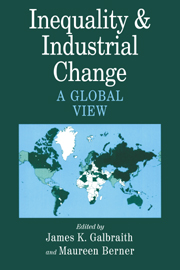Book contents
- Frontmatter
- Contents
- Contributors
- Permissions
- Acknowledgments
- PART I INTRODUCTION TO THEORY AND METHOD
- PART II INEQUALITY, UNEMPLOYMENT, AND INDUSTRIAL CHANGE
- PART III INEQUALITY AND DEVELOPMENT
- 7 Toward a New Kuznets Hypothesis: Theory and Evidence on Growth and Inequality
- 8 Measuring the Evolution of Inequality in the Global Economy
- 9 Economic Regionalization, Inequality, and Financial Crises
- 10 Inequality and State Violence: A Short Report
- 11 Grading the Performance of Latin American Regimes, 1970–1995
- 12 The Evolution of Industrial Earnings Inequality in Mexico and Brazil
- 13 The Legacy of the HCI: An Empirical Analysis of Korean Industrial Policy
- 14 Inequality and Economic Development: Concluding Reflections
- PART IV METHODS AND TECHNIQUES
- Data Appendix
- References and Selected Bibliography
- Index
10 - Inequality and State Violence: A Short Report
Published online by Cambridge University Press: 05 June 2012
- Frontmatter
- Contents
- Contributors
- Permissions
- Acknowledgments
- PART I INTRODUCTION TO THEORY AND METHOD
- PART II INEQUALITY, UNEMPLOYMENT, AND INDUSTRIAL CHANGE
- PART III INEQUALITY AND DEVELOPMENT
- 7 Toward a New Kuznets Hypothesis: Theory and Evidence on Growth and Inequality
- 8 Measuring the Evolution of Inequality in the Global Economy
- 9 Economic Regionalization, Inequality, and Financial Crises
- 10 Inequality and State Violence: A Short Report
- 11 Grading the Performance of Latin American Regimes, 1970–1995
- 12 The Evolution of Industrial Earnings Inequality in Mexico and Brazil
- 13 The Legacy of the HCI: An Empirical Analysis of Korean Industrial Policy
- 14 Inequality and Economic Development: Concluding Reflections
- PART IV METHODS AND TECHNIQUES
- Data Appendix
- References and Selected Bibliography
- Index
Summary
This chapter presents a brief review of the relationship between various forms of state violence–including war, revolution, civil violence, and coups d'état–and a measure of inequality of manufacturing earnings in countries around the world over the period 1960 to 1995. We find evidence of several systematic relationships, of which the strongest and most striking is that coups precede a long period of rising inequality with a very high probability.
Introduction
This chapter asks whether there exist systematic relationships between levels of state violence and changes in economic inequality in countries around the world. The question is, of course, quite natural. Entire lexicons exist that describe economic relationships in terms that evoke violence; exploitation, dependency, unequal exchange, and class struggle are but prominent examples. And the case histories of war, revolution, repression, and coups d'état are loaded with what seem – transparently – to be efforts either to rectify gross inequalities or to impose them.
Yet from the standpoint of an empiricist interested mainly in the search for patterns in data, substantial obstacles stand in the way of definite observations. First of all, there is the difficulty that reliable measures of short-term change in economic inequality, measures that are both consistent and consistently available, particularly in countries that have been wracked by violence, have not existed. Second, there is the problem of arriving at a consistent categorization of types of violence, so that one may define the predicted effect of each type on economic inequality and vice versa.
- Type
- Chapter
- Information
- Inequality and Industrial ChangeA Global View, pp. 202 - 211Publisher: Cambridge University PressPrint publication year: 2001



